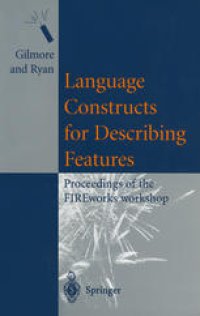
Ebook: Language Constructs for Describing Features: Proceedings of the FIREworks workshop
- Tags: Special Purpose and Application-Based Systems, Software Engineering, Communications Engineering Networks, Programming Languages Compilers Interpreters, Logics and Meanings of Programs
- Year: 2001
- Publisher: Springer-Verlag London
- Edition: 1
- Language: English
- pdf
A feature is a small modification or extension of a system which can be seen as having a self-contained functional role, such as Call Forwarding, Automatic Call back and Voice Mail in telephone services, to which users can subscribe. Feature interaction happens when one feature modifies or subverts the operation of another, and this problem has received a great deal of attention from industry and academics, especially in the field of telecommunications, where new services are constantly being developed and deployed. This volume contains refereed papers resulting from the ESPRIT FIREworks working group. The papers focus on the language constructs which have been developed describing features, and advocate a feature-oriented approach to software design including requirements specification languages and verifications logics.
A feature is a small modification or extension of a system which can be seen as having a self-contained functional role, such as Call Forwarding, Automatic Call back and Voice Mail in telephone services, to which users can subscribe. Feature interaction happens when one feature modifies or subverts the operation of another, and this problem has received a great deal of attention from industry and academics, especially in the field of telecommunications, where new services are constantly being developed and deployed. This volume contains refereed papers resulting from the ESPRIT FIREworks working group. The papers focus on the language constructs which have been developed describing features, and advocate a feature-oriented approach to software design including requirements specification languages and verifications logics.
A feature is a small modification or extension of a system which can be seen as having a self-contained functional role, such as Call Forwarding, Automatic Call back and Voice Mail in telephone services, to which users can subscribe. Feature interaction happens when one feature modifies or subverts the operation of another, and this problem has received a great deal of attention from industry and academics, especially in the field of telecommunications, where new services are constantly being developed and deployed. This volume contains refereed papers resulting from the ESPRIT FIREworks working group. The papers focus on the language constructs which have been developed describing features, and advocate a feature-oriented approach to software design including requirements specification languages and verifications logics.
Content:
Front Matter....Pages I-X
Structuring Telecommunications Features....Pages 1-9
Feature-Oriented Description, Formal Methods, and DFC....Pages 11-26
Use Case Maps as a Feature Description Notation....Pages 27-44
An incremental method for the design of feature-oriented systems....Pages 45-64
Abstraction and refinement of features....Pages 65-84
Proving feature non-interaction with Alternating-Time Temporal Logic....Pages 85-103
Algebraic Treatment of Feature-oriented Systems....Pages 105-124
The PEPA Feature Construct....Pages 125-142
A Heuristic Algorithm to Detect Feature Interactions in Requirements....Pages 143-162
Defining Features for CSP: Reflections on the Feature Interaction Contest....Pages 163-175
Stack Service Model....Pages 177-196
The Declarative Language STR (State Transition Rule)....Pages 197-211
Modular Feature Integration and Validation in a Synchronous Context....Pages 213-231
Back Matter....Pages 233-233
A feature is a small modification or extension of a system which can be seen as having a self-contained functional role, such as Call Forwarding, Automatic Call back and Voice Mail in telephone services, to which users can subscribe. Feature interaction happens when one feature modifies or subverts the operation of another, and this problem has received a great deal of attention from industry and academics, especially in the field of telecommunications, where new services are constantly being developed and deployed. This volume contains refereed papers resulting from the ESPRIT FIREworks working group. The papers focus on the language constructs which have been developed describing features, and advocate a feature-oriented approach to software design including requirements specification languages and verifications logics.
Content:
Front Matter....Pages I-X
Structuring Telecommunications Features....Pages 1-9
Feature-Oriented Description, Formal Methods, and DFC....Pages 11-26
Use Case Maps as a Feature Description Notation....Pages 27-44
An incremental method for the design of feature-oriented systems....Pages 45-64
Abstraction and refinement of features....Pages 65-84
Proving feature non-interaction with Alternating-Time Temporal Logic....Pages 85-103
Algebraic Treatment of Feature-oriented Systems....Pages 105-124
The PEPA Feature Construct....Pages 125-142
A Heuristic Algorithm to Detect Feature Interactions in Requirements....Pages 143-162
Defining Features for CSP: Reflections on the Feature Interaction Contest....Pages 163-175
Stack Service Model....Pages 177-196
The Declarative Language STR (State Transition Rule)....Pages 197-211
Modular Feature Integration and Validation in a Synchronous Context....Pages 213-231
Back Matter....Pages 233-233
....